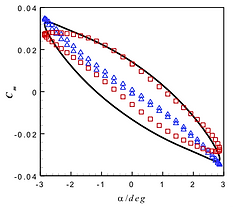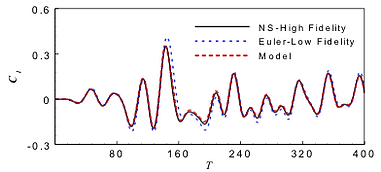Bridging data-driven modeling and CFD
Data-driven multi-fidelity modeling of unsteady aerodynamics
Aerodynamic models can be constructed from multiple types of data (i.e., flight test, experiment, numerical simulation, etc.), but the cost and the accuracy of data is different. This work tries to reduced the total cost for aerodynamic modeling by incorporating different types of data (a few high-fidelity data + a low-fidelity model), and achieves high-fidelity aerodynamic prediction. Main research topics involve:
-
Developing data-driven frameworks to model the difference between the low-fidelity and the high-fidelity models.
-
Using reduced-order models as the low-fidelity model to accelerate the multi-fidelity aerodynamic prediction.
-
Reconstructing high-fidelity experimental results by the proposed multi-fidelity modeling approach and numerical simulation with very low experimental cost or limited data (e.g., a few pressure sensors).
An example for current research:
This examples tries to reproduce high-fidelity unsteady aerodynamic loads of RANS equations by using only a few high-fidelity training cases of harmonic motions (which are always used in experiment) and low-fidelity solution of Euler equations. At each time instant:
fHF (k) = fLF (k) + s(x(k))
where x(k) is the state vector characterizing unsteady effects:
x(k)=[u(k), u(k-1),..., u(k-m), fLF(k-1),..., fLF(k-n)]'





Sampling space [amplitude, reduced frequency] from Latin Hypercube Sampling and training harmonic motions
Harmonic test case (amplitude 2.9 degree, k = 0.1636)
Random test case (maximum amplitude 2.96 degree)